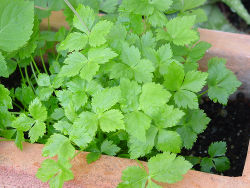Owing to the screen size of your device, you may obtain a better viewing experience by
rotating your device a quarter-turn (to get the so-called "panorama" screen view).
|
This page updated for 2022.
|
Click here for the site directory.
|
|
Please consider linking to this site!
|
Click here to email us.
|
Mitsuba
(Cryptotaenia japonica)
About Mitsuba
Mitsuba is, as the name indicates, an herb of Japanese extraction (we gather the name means “three leaves”). It is said to have a flavor rather like parsley (which it physically resembles), but somewhat milder (though others say it is like Angelica). One blogger described the taste so: “Subtle. Maybe just a little nutty. Fresh. Maybe a little celery orientation. The herb is listed as Japanese Parsley, or Japanese Chervil, so that gives a good hint as to the flavor it imparts to foods.” Though the plant’s stems are cooked in the Orient for special uses (such as tying up sushi rolls), in western cuisine what’s wanted is the leaves—used raw, not cooked into dishes, as cooking destroys the flavor (as with chervil).
It is a hardy perennial, and is typically in leaf the year round. It is, however, usually grown as an annual.
Cultivars

In Japan, whence the herb originates, it is widely grown and there are named cultivars; but if there are any available by name in North America, we haven’t seen them: the seeds are invariably called simply “mitsuba”. There is a related species, C. canadensis, apparently also sometimes used as a flavoring, but we’d say just stick to offering of “mitsuba”. (Though occasionally it is called, variously, Japanese wild parsley, Japanese chervil, honeywort, san ip, or san ye qin.)
Seeds are scarce in the U.S., but by no means unfindable.
Planting
Mitsuba is apparently not fussy about its soil, tolerating extremes of pH and even nutrient-poor conditions. It wants limited sun; too much will turn the leaves yellow. Give it some definite shade, or grow it indoors (it is an excellent candidate for container growing).
Direct-seed it fairly early in the season, preferably in a modest-sized container or pot. Chances are it will come up again by itself every year thereafter, whether by survival (it is a perennial) or by re-seeding (which it is said to do freely).
Growing
Mitsuba wants good watering, though—like most herbs—doesn’t like “wet feet”, so arrange for good drainage. Beware slugs, which seem to like it.
Harvest a few leaves as needed. Left uncut, the plant can reach two feet in height. Keep the small, white blossoms trimmed. Note well that to preserve its fragrance, it should never be more than at very most briefly parboiled: add it to cooked dishes just before serving.
Relevant Links
Besides any links presented above on this page, the following ought to be especially helpful.
Return to the top of this page.
If you find this site interesting or useful, please link to it on your site by cutting and pasting this HTML:
The <a href="https://growingtaste.com/"><b>Growing Taste</b></a> Vegetable-Gardening Site
—Site Directory—
Search this site, or the web
-
Background Information
about the purposes and design of this site
- Site Front Page
-
Introduction

- An Apologia: why one should cultivate one's garden
- Deep-Bed Gardening (forthcoming)
- Container Gardening (forthcoming)
- Vegetarian and Organic Considerations (forthcoming)
-
Recommended Crops for a home garden, by variety
-
Gardening information and aids
-
Miscellaneous Information of interest to the home gardener
Since you're growing your own vegetables and fruits, shouldn't you be cooking them in the best way possible?
Visit The Induction Site to find out what that best way is!
|
If you like good-tasting food, perhaps you are interested in good-tasting wines as well?
Visit That Useful Wine Site for advice and recommendations for both novices and experts.
|

|
This site is one of The Owlcroft Company family of web sites. Please click on the link (or the owl)
to see a menu of our other diverse user-friendly, helpful sites.
|
|
 Like all our sites, this one is hosted at the highly regarded Pair Networks,
whom we strongly recommend. We invite you to click on the Pair link for more information on getting your site or sites hosted on a first-class service.
Like all our sites, this one is hosted at the highly regarded Pair Networks,
whom we strongly recommend. We invite you to click on the Pair link for more information on getting your site or sites hosted on a first-class service.
|
|
All Owlcroft systems run on Ubuntu Linux and we heartily recommend it to everyone—click on the link for more information.
|
Click here to send us email.
Because we believe in inter-operability, we have taken the trouble to assure that
this web page is 100% compliant with the World Wide Web Consortium's
XHTML Protocol v1.0 (Transitional).
You can click on the logo below to test this page!
You loaded this page on
Thursday, 25 April 2024, at 02:30 EDT.
It was last modified on Monday, 10 January 2022, at 06:05 EST.
All content copyright ©1999 - 2024 by
The Owlcroft Company

